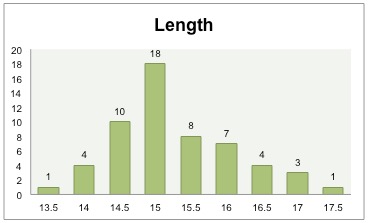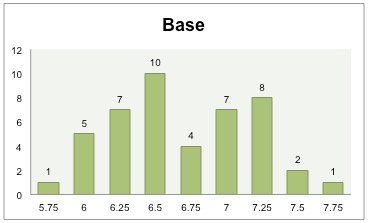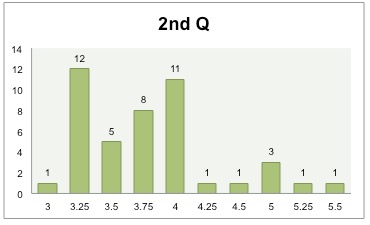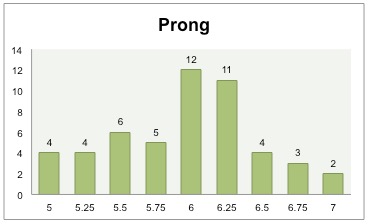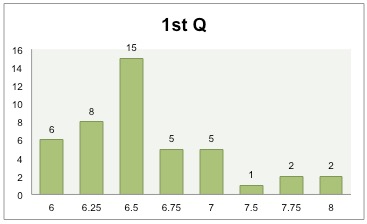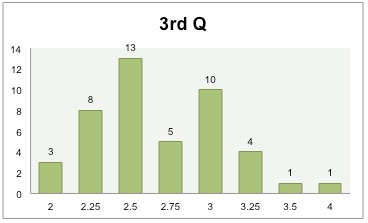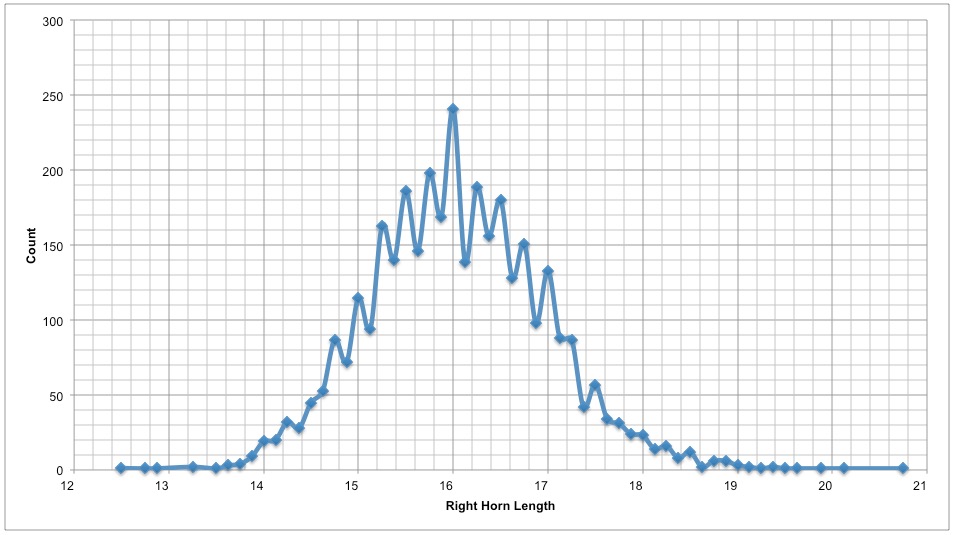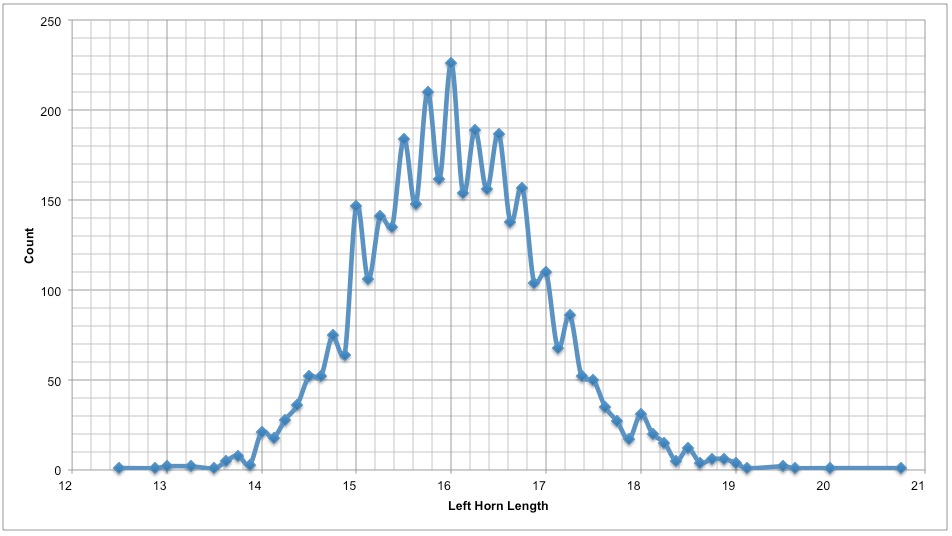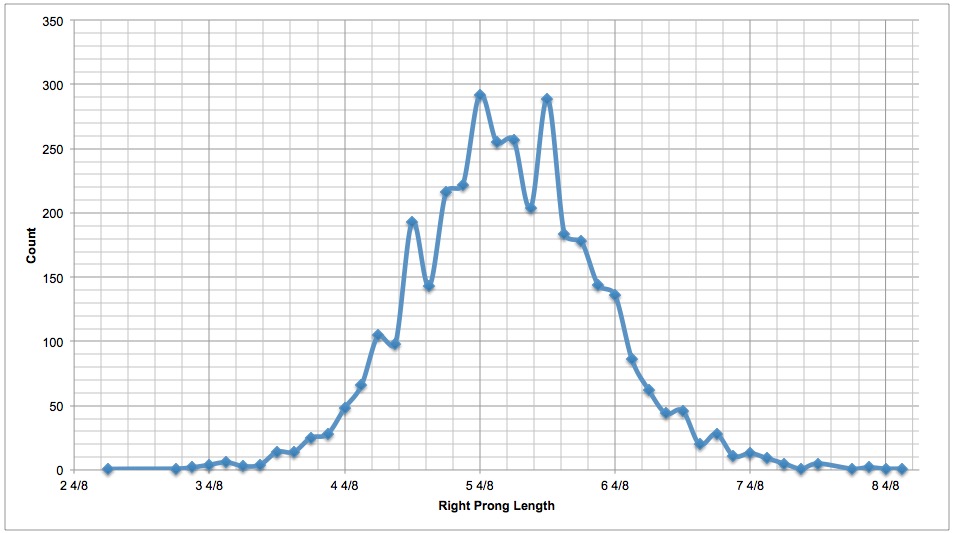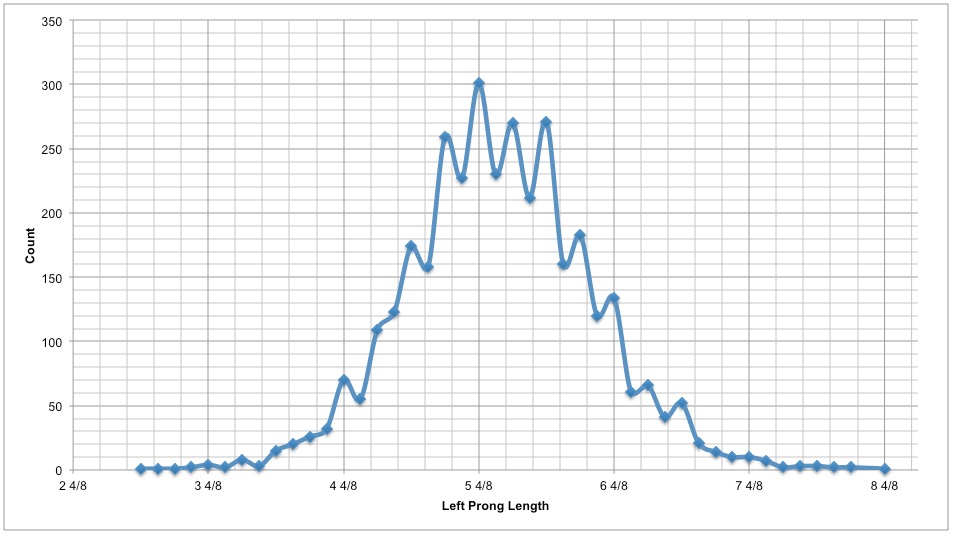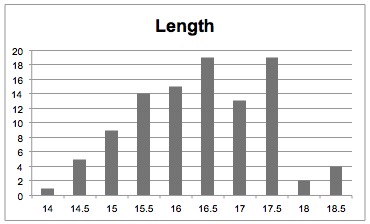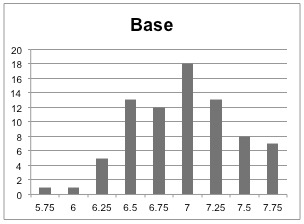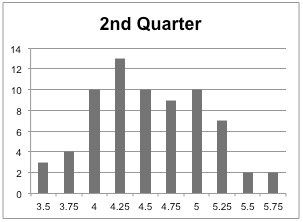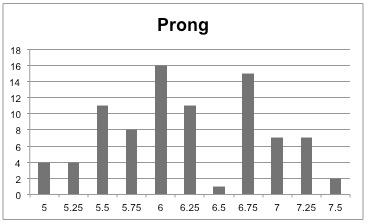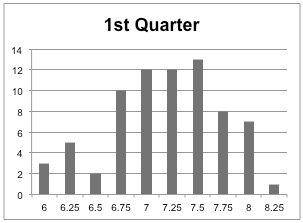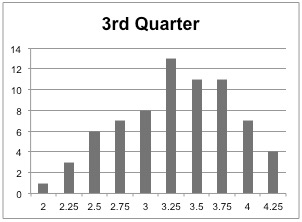|
Once again I think the crowd created a very credible forecast for this buck's score. There were a total of 54 votes cast to create this breakdown:
Length: 15 2/8 Prong: 6 Total Length: 21 2/8 Base: 6 6/8 1st Q: 6 5/8 Bottom Mass: 13 3/8 2nd Q: 3 7/8 3rd Q: 2 5/8 Top Mass: 6 4/8 There isn't much for me to improve upon with these numbers as they're once again very close to my guess. If I were to change anything it would probably be the prong length. I'd increase it by maybe 1/8 or so. Very minor detail which wouldn't influence the score much. There is one thing I'll address: Field Judging Tip: The majority of the time when a buck has big prongs fairly close to it's head, the 1st Q measurement will almost always be the same size or larger than the base measurement. Once in awhile you'll notice that the base will "mushroom" from the front view, and in cases like that the base might be larger. In the case of the buck in this poll I'd say the base and 1st Q are very similar from the front and that the buck's two measurements will follow the normal pattern of being the same size or the 1st Q being slightly larger. With that said I think I like the measurement numbers for the base and 1st Q, but I'd like to see them flip flopped. If anyone has any comments or thoughts on how to make the analysis better please let me know. I'm having fun with these, I hope everyone else is too. The graphed results are below. I was looking at all the pronghorn scoring stats I could possibly dig up through the B&C Trophy Search. While looking through the B&C data on 3467 bucks (data was pulled from the site 6/21/2015) I noticed something peculiar. It seems as though B&C scorers have a strong bias toward measuring the length and prong in whole quarter numbers rather than in the smaller eighth increments. Of the 3467 bucks, 57.14% of the length measurements and 56.23% of the prong measurements ended in either 0/8", 2/8", 4/8" or 6/8". The odd eighth's of 1/8", 3/8", 5/8", and 7/8" occurred on only 42.86% and 43.77% of the trophies. I've attached the graphs of both of these occurrences broken down into right and left horns. In the charts it's easy to see the strange trend with the jagged lines. What does it all mean? It means that B&C scorers may subconsciously fall into the trap of using even numbers. One reason for this, according to the studies that I've looked up, is that even numbers are more liked and are more easily added and subtracted.
Here's one of the articles I found: Why Odd Numbers are Dodgy, Evens are Good, and 7 is Everyone's Favorite Edit: I've decided there could be a couple more possibilities that I've overlooked that have nothing to do with psychology. 1. There could be a certain number of measurers who, for whatever reason, are using tape measures that only have quarter inch marks. I'm sure this isn't common, but it has to be a possibility given the evidence. 2. More likely than 1 is that there could be numerous scorers who have old tape measures that simply have been worn out over time. This could make the dashes on the 1/8 marks very hard to read and therefore easier to skip past when looking at the tape. There are probably other reasons I haven't considered as well. Does this affect anything with regards to scoring or field judging? I haven't decided yet. The results are in on Field Judging Poll #1. I'm very happy with how the judging turned out. Nearly 100 people voted so I think the results should provide some decent data.
The average results were: Length: 16 3/8 Prong: 6 2/8 Base: 7 1st Q: 7 1/8 2nd Q: 4 4/8 3rd Q: 3 2/8 These numbers equate to 14 1/8 on the Bottom Mass and 7 6/8 on Top Mass for 21 7/8 of Total Mass. Total Length is 22 5/8. The overall average score is 89.18 inches (I rounded on the other numbers for simplicity). These numbers are actually really good and very close to my numbers on this buck. I have him guessed at 90 2/8 overall. Length: I have the buck guessed at exactly the same length as the average of the poll - 16 3/8. I have him at 7 6/8 from the base to the intersection of the prong (the "to the prong" measurement or "TP" for short.) I then have him at 8 5/8 from the intersection of the prong to the tip of the horn (the "past the prong" measurement" or "PP" for short.) These numbers are based on giving the buck a 6 6/8" ear and an 8" face. The ear measurement seems off as bucks in this area generally have longer ears than that. An 8" face is reasonable to expect in this area. The eye is set at 1 6/8 which is smaller than usual. All of this could mean that my estimate and the crowds average estimate is on the conservative side. However, these photos were taken June 4th so the buck should grow at least another half inch, maybe more. I expect the final length measurement to be closer to 17 inches. Prong: I have his prong a hair shorter than the crowd at 6". This is based on giving him 3 3/8" of prong protruding off the main horn (the "off the horn" measurement or "OH" for short.) This would obviously mean he would have 2 5/8" of prong length around to the back of the horn (the "behind the prong" measurement or "BP" for short.) My guess of 3 3/8 is based on assuming that the left prong is slightly shorter than the right prong which may or may not be true. And given the mass this buck has on his 2nd Quarter I may be underestimating the BP by 1/8. (A little tip on guessing prong length - almost all mature AZ and NM bucks have a BP measurement of between 2 and 2 6/8. Only the very thinnest of bucks will be smaller than 2 and only the freaks will be more than 2 6/8.) Bottom Mass: I have the base at 7 2/8" and the 1st Quarter at 7 5/8". Both of these are larger than the crowd by a total of 6/8 inches. These two measurements have the largest discrepancy between the crowd and I. I'm not sure why, but if the buck tightens up slightly while he grows a half inch longer over the summer, the final measurements could be more in line with the crowd than mine are now. Top Mass: I have the 2nd and 3rd Quarter at 4 6/8" and 3 1/8" for 7 7/8" of Top Mass - only 1/8" different than the crowd. I think I probably have the 2nd Q higher because of where I believe the measurement will fall - which is to say I think it will be very close to the prong and be larger than it might be on a buck with prongs closer to it's head. All of this said I usually underestimate on purpose and the bucks usually end up scoring 1 or 2 inches bigger than I guess in the field. I like to err on the side of caution when field judging and then be pleasantly surprised when the hunt is over. It's much better than the alternative. If you played along and are getting lost with all of our mumbo jumbo then you might want to check out our field judging DVD. It explains a lot of what I refer to in this post. Here are the data charts from the poll: |
Details
HuntsArchives
January 2020
Categories
All
|

